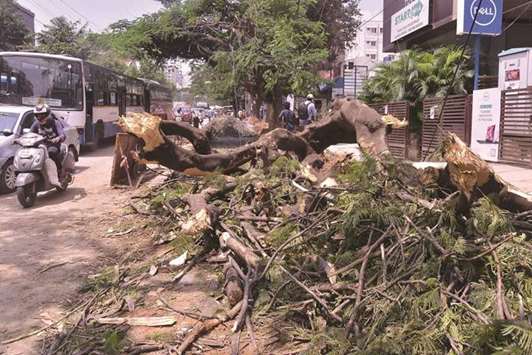“In the past two days, over 300 trees have been uprooted due to heavy rain in Bengaluru,” Deputy Chief Minister G Parameshwara tweeted.
“To clear this (uprooted trees) and prevent inundation of low-lying areas, BBMP (city’s civic authority) has deployed zone-wise teams that are working on a war footing to restore normalcy in the city,” added Parameshwara, who also holds the Bengaluru Development portfolio.
The city has received an average rainfall of 6.3cm across the suburbs, with certain areas receiving a maximum rainfall of up to 20.6cm, according to the Karnataka State Natural Disaster Monitoring Centre (KSNDMC).
The rains, which have been lashing the city since Sunday, have also flooded underbridges and roads, disrupting traffic.
The downpour has been intense over the past two days in the southern and south-western suburbs of the city, where the basements of several apartment buildings have been flooded.
After the overnight rain on Monday, the Bellandur lakes, the largest in Bengaluru, was seen covered in a toxic foam. Similar froth had led to the lake catching fire on several occasions earlier.
Civic officials, who have been clearing the uprooted trees across the city, have been receiving distress calls from residents in the low-lying areas about over-flowing storm water drains and flooded basements.
The rains could continue across the city over the week due to an active south west monsoon, according to India Meteorological Department (IMD) Bengaluru director C S Patil.
“Due to the active south-west monsoon and air circulation over south interior districts, Bengaluru will continue to see heavy rains for the next four days,” Patil said.
“...BBMP officials are on high alert and people residing in low-lying areas should be cautious. #BengaluruRains,” tweeted Chief Minister H D Kumaraswamy.
Heavy rain was also witnessed across the neighbouring districts including Ramanagara, Tumakuru and Chamarajanagar.
Meanwhile, the Yamuna river in Delhi is flowing above the danger level following the release of water from Haryana’s Hathnikund barrage in the wake of heavy rains and flash floods in parts of Uttarakhand, Himachal Pradesh and Punjab.
These states have witnessed downpours in the last few days due to which the water level in the rivers has increased.
The warning level mark of the Yamuna is 204m and the danger level mark is 204.83m.
Delhi Chief Secretary Anshu Prakash has called an emergency meeting to decide the steps to deal with exigencies.
“The water level of river Yamuna at Delhi Railway Bridge at 11am was 205.12m,” a Flood and Control Department official said.
“The water is showing a rising trend and is expected to go up as Delhi is witnessing rains and more water is being released every hour from the barrage,” he added.
The water discharged from Hathnikund barrage, which provides drinking water to the national capital, normally takes 72 hours to reach, he said.
Delhi witnessed the worst-ever floods in 1978 when the river’s level touched a record 207.49m.



